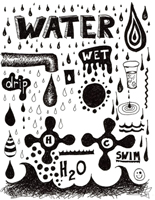Module 1 Intro
1. Module 1 Intro
1.16. Page 2
Module 1—Energy Flow and the Cycling of Matter

© Stacey Walker/iStockphoto
 Explore
Explore
 Read
Read
Begin your introduction to this lesson by reading pages 34 to 36 of your textbook. Water has many unique properties that make it an important part of cycling matter. This part of the textbook revisits what you have learned about water in Science 10, such as heat capacity, adhesion, cohesion, and the ability to dissolve many substances. Water, through the hydrologic cycle, cycles substances important to biosphere equilibrium.
 Self-Check
Self-Check
SC 1. Do you know your water cycle? Do a review by looking at the diagram in the "Check your work" box. See if you know how to correctly label the hydrologic cycle.
SC 2. Why is water considered to be the “universal solvent”? How is this useful?
 Self-Check Answers
Self-Check Answers
SC 1.
SC 2. Because water is a polar molecule, the positively charged hydrogen atoms easily form bonds with negatively charged ionic molecules. The negatively charged oxygen atom will also form an ionic bond with positively charged ionic molecules. Therefore, water will dissolve almost any ionic compound. Since it dissolves so many compounds, water then has the ability to transport ionic compounds where they are needed. For example, phosphorus in the soil dissolves in water in order to get to the roots of plants
 Read
Read
Continue reading from pages 36 to 37 in your textbook. Start reading at “Hydrogen Bonding Affects Water in Different Phases.”
 Self-Check
Self-Check
SC 3. Look at this photo.

© Doug Nelson/iStockphoto
What property of water causes water to bead on surfaces? Explain.
SC 4. Answer question 2 on page 37 of the textbook.
SC 5. Why does ice float? Why is this important?
 Self-Check Answers
Self-Check Answers
SC 3. Hydrogen bonding or cohesion, which is the attraction of water molecules to each other (polarity), causes surface tension.
SC 4.
2.
- Water has a 100°C temperature range before it will change state (ice or vapor). Therefore, water has the ability to transport nutrients in varying conditions (e.g., Arctic versus tropical conditions). Water must be liquid (aqueous) to dissolve substances.
- Water changes density as it cools, which will cause it to sink and rise and cycle oxygen and nutrients. Water is most dense at 4°C.
- Adhesion provides an upward force on water and counteracts the pull of gravity. Cohesion happens because water molecules are more attracted to themselves than other molecules (to a point), and as one molecule moves out of the plant (transpiration), another will take its place.
SC 5. Ice floats because it is less dense than water. If ice was denser, life in aquatic systems would die every winter if a body of water froze from the bottom up.